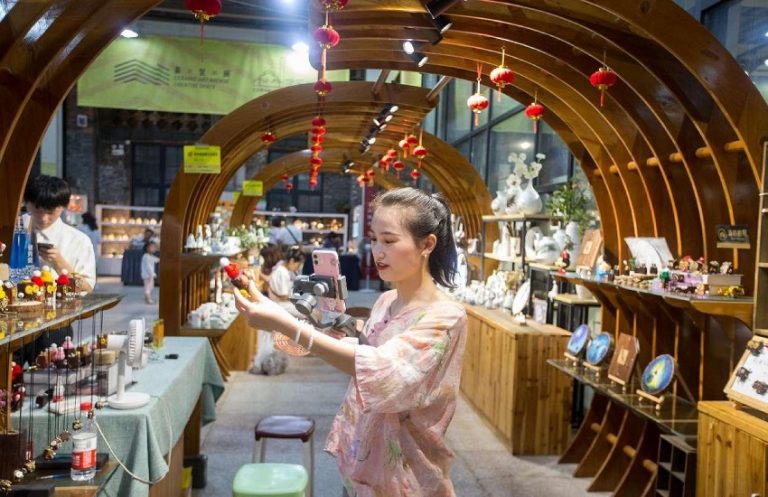
By Ye Zi, As the night descended, Taoxichuan Ceramic Art Avenue, a cultural and creative block in Jingdezhen, east China’s Jiangxi province, buzzed with a constant flow of people. Visitors were captivated by a dazzling collection of delicate ceramic handicrafts.
Wu Anran, a young designer, is no stranger to this scene. A decade ago, she started her business in Jingdezhen and had a stall in the area. Today, Wu owns her studio, and her ceramic works have gained widespread popularity at home and abroad.
Jingdezhen, known as China’s “porcelain capital,” has become a magnet for young entrepreneurs like Wu.
In recent years, more than 60,000 people from all around the world have settled in this city, including over 5,000 foreigners at peak. Drawn by the allure of porcelain, these people have found a sense of belonging and fulfillment in Jingdezhen, where their dreams are realized.
Ceramics is a cultural treasure of China, playing a significant role in the country’s history of international cultural exchange. Jingdezhen boasts more than 2,000 years of pottery history, over 1,000 years of official kiln history, and over 600 years of imperial kiln history.
For more than 1,000 years, Jingdezhen ceramics have traveled along the Maritime Silk Road to the globe. Today, its rich ceramic culture continues to thrive, as different civilizations converge and blend in Jingdezhen.
“Anyone working with ceramics will want to come to Jingdezhen,” said Stan from the Democratic Republic of the Congo.
Renowned for its high-quality clay used in porcelain manufacturing, Jingdezhen has a multitude of artisans and kilns gathered, attracting art lovers from across the globe who come here to learn, create, and exchange ideas.
Jingdezhen Ceramic University, located in the city, is the only multidisciplinary university in China named after ceramics.
In 2013, Stan came to the university to pursue a master’s degree in traditional ceramic techniques. Today, he teaches at a school in his country and frequently visits Jingdezhen for learning and exchange.
“I’m captivated by the diverse range of porcelain here and the cultural atmosphere of Jingdezhen, which sparks my creativity,” Stan expressed.
Jingdezhen Ceramic University has attracted over 3,000 international students from more than 60 countries and regions since the 1950s.
In 2021, South Korean artist Song Yeon-joo visited Jingdezhen for the first time and was fascinated by the abundance of ceramic workshops here. Previously focused on acrylic painting, Song expanded her artistic horizons when a friend suggested that she could combine painting with ceramics during her time in Jingdezhen.
The combination of traditional ceramic textures and modern abstract paintings is truly captivating.
“I adore the blue and white porcelain from Jingdezhen and I think it’s a perfect fit for my ocean-themed ceramic paintings!” Song exclaimed excitedly.
“Here, no matter what kind of creativity you have, it will be embraced and can become a reality,” she said.
Despite its small size, Jingdezhen serves as a global hub connecting people from all over the world.
Next to the site of an imperial kiln factory, there are art galleries, artists’ studios, and other facilities. Regular events such as salons, lectures, and forums provide a platform for young people from various countries and cultural backgrounds to exchange and share ideas.
At a site of kilns that date back to the Ming and Qing dynasties (1368-1911), domestic and foreign tourists paid a daily visit to learn pottery techniques from inheritors of intangible cultural heritage.
In an international ceramic art village in Jingdezhen, artists with diverse styles come together to exchange production techniques, igniting creativity and inspiration.
Jingdezhen has forged friendly relations with more than 180 cities in 72 countries. The renowned Taoxichuan International Art Center has become a hub for artists from over 50 countries, infusing the city with an international perspective and a dynamic creative ambiance.
These artists draw inspiration from the rich heritage of Jingdezhen, using their artistic skills to propel the innovative growth of ceramic art and the wide promotion of ceramic culture.
The ceramic industry in Jingdezhen is flourishing, generating a revenue of 66 billion yuan (about $9.21 billion) in 2022. The local government has implemented favorable policies to support talented individuals who have chosen to settle in the city. These policies aim to preserve and develop the ceramics industry, fostering a community of skilled ceramic artisans and enthusiasts.
“Jingdezhen had numerous guilds during the Ming and Qing dynasties, and the city has always been renowned for its thriving and diverse communities. Its inclusive and openness constitute the city’s cultural character, which is undoubtedly attractive to the younger generation,” stated He Ding, an associate professor at the School of Architecture and Urban Planning, Beijing University of Civil Engineering and Architecture.
With its complete ceramic production processes, well-established industrial infrastructure, rich cultural heritage, and distinctive urban spaces, Jingdezhen offers ample opportunities for cultural exchange and mutual learning of civilizations, providing people with more opportunities to pursue their dreams, He said.










